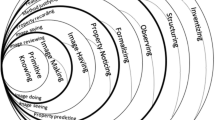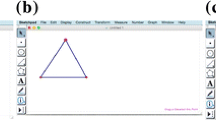Abstract
To make optimal use of computational environments, one must understand how students interact with the environments and how students' mathematical thinking is reflected and affected by their use of the environments. Similarly, to make sense of research on students' thinking and learning, one must understand how the environments and contexts used in the research may affect the conclusions one derives.
The research on students' learning of functions has approached the topic in terms of symbols and graphs (see, for example, Leinhardt et al. (1990) for a review of work up to that point; Harel and Dubinsky (1992) for a collection of research; and Dugdale et. al. (1995), for some recent thinking about implications for curriculum reform using technology). Dynamic geometry environments (DGEs) like Cabri Geometry or Geometer's Sketchpad, offer us an opportunity to get a new perspective on these old and important issues. DGEs let students build geometrical constructions and then drag certain objects around the screen in a continuous manner while observing how the entire construction responds dynamically. In this way DGEs model functional relationships that are not specified by symbols or represented by graphs.
Based on interviews with undergraduate mathematics majors, this paper presents preliminary observations that confirm some old results and raise some new questions about students' notions of function.
Similar content being viewed by others
References
Baulac, Y, Bellemain, F. and Laborde, J. M., designers (1990). Cabri: The Interactive Geometry Notebook. Cabri Géomètre. Pacific Grove, CA: Brooks-Cole.
Baulac, Y, Bellemain, F. and Laborde, J. M., designers (1994). Cabri II. Dallas, TX: Texas Instruments.
Breidenbach, D., Dubinsky, E., Hawks, J. and Nichols, D. (1992). Development of the process conception of function. Educational Studies in Mathematics 23(3): 247–285.
Brock, C. F., Cappo, M., Dromi, D., Rosin, M. and Shenkerman, E. designers (1994). Tangible Math: Geometry Inventor. Cambridge, MA: Logal Educational Software and Systems.
Capponi, B. (1992). Cabi Geometre in a college classromm: Teaching and learning the cosine-function. ZDM 5: 165–171.
Cuoco, A. (1993). Action to process: Constructing functions from algebra word problem. Intelligent Tutoring Media 4(3/4): 117–127.
Dugdale, S., Thompson, P. W., Harvey, W., Demana, F., Waits, B. K., Kieran, C., McConnell, J. W. and Christmas, P. (1995). Technology and algebra curriculum reform: Current issues, potential directions, and research questions. Journal of Computers in Mathematics and Science Teaching 14(3): 325–357.
Goldenberg, E. P. (1988). Mathematics, metaphors, and human factors: Mathematical, technical, and pedagogical challenges in the educational use of graphical representation of functions. Journal of Mathematical Behavior 7: 135–173.
Goldenberg, E. P. and Cuoco, A. A. (1996). What is dynamic geometry? In R. Lehrer and D. Chazan (Eds.), Designing Learning Environments for Developing Understanding of Geometry and Space. Hillsdale, NJ: Lawrence Erlbamn Associates.
Goldenberg, E. P., Lewis, P. and O'Keefe, J. (1992). Dynamic representation and the development of a process understanding of function. In G. Harel and E. Dubinsky (Eds.), The Concept of Function: Aspects of Epistemology and Pedagogy. MAA Notes, Volume 25 1992, Washington, DC: Mathematical Association of America.
Harel, G. and Dubinsky, E. (Eds.) (1992). The Concept of Function: Aspects of Epistemology and Pedagogy. Washington, D.C.: Mathematical Association of America.
Hazzan, O. (1996). On topological properties of functions. For the Learning of Mathematics 16(3): 39–42.
Holland, G. (1993). GEOLOG. Geometrische Konstruktionen mit dem Computer. Bonn: Dümmler.
Hölzl, R. (1996). How does ‘dragging’ affect the learning of geometry? International Journal for Computers in Math Learning 1(2): 169–187.
Jackiw, N. designer (1991). The Geometer's Sketchpad. Berkeley, CA: Key Curriculum Press.
Jackiw, N. designer (1995). The Geometer's Sketchpad, v, 3.0. Berkeley, CA: Key Curriculum Press.
Kadunz, G. and Kautschitsch, H. (1994): Thales. Experimentelle Geometrie mit dem Computer. Klett: Stuttgart.
Laborde, C. (1995). Designing tasks for learning geometry in a computer based environment. In L. Burton and B. Jaworski (Eds.), Technology in Mathematics Teaching — A Bridge Between Teaching and Learning (pp. 35–68). Londres: Chartwell-Bratt.
Laborde, C. and Laborde, J.-M. (1995). What about a learning environment where Euclidean concepts are manipulated with a mouse? In A. DiSessa, C. M. Hoyles, R. Noss and L. Edwards (Eds.), Computers and Exploratory Learning. NATO ASI Series, Berlin: Springer Verlag.
Laborde, J. M. and Straßer, R. (1990). Cabri-Geometre: A microworld of geometry for guided discovery learning. ZDM 5: 171–190.
Leinhardt, G., Zaslavsky, O. and Stein, M. K. (1990). Function, graphs, and graphing: Tasks, learning, and teaching. Review of Educational Research 60(1): 1–64.
Mechling, R. (1994): Euklid. Internet: http//:wmax02.mathematik.uni-wuerzburg.de:80/-weth/programme/Euklid.zip
Papert, S. (1980). Mindstorms: Children, Computers and Powerful Ideas. New York: Basic Books, Inc., Publishers.
Piaget, J., Grize, J. B., Szeminska, A. and Bang, V. (1977). Epistemology and Psychology of Functions. Dordrecht, Holland: D. Reidel Publishing Company.
Scher, D. (1996). Folded paper, dynamic geometry, and proof: A three-tier approach to the conics. Mathematics Teacher 89: 188–193.
Schwartz, J. and Yerushalmy, M., designers (1992). The Geometric SuperSupposer. Pleasantville, NY: Sunburst Communications.
Sfard, A. (1992). Operational origins of mathematical objects and the quandary of reification — the case of function. In E. Dubinsky and G. Harel (Eds.), The Concept of Function: Aspects of Epistemology and Pedagogy, MAA Notes.
Vinner, S. (1983). Concept definition, concept image and the notion of function. International Journal of Mathematical Education in Science and Technology 14: 293–305.
Author information
Authors and Affiliations
Rights and permissions
About this article
Cite this article
Hazzan, O., Goldenberg, E.P. Students' understanding of the notion of function in dynamic geometry environments. Int J Comput Math Learning 1, 263–291 (1997). https://doi.org/10.1007/BF00182618
Published:
Issue Date:
DOI: https://doi.org/10.1007/BF00182618




